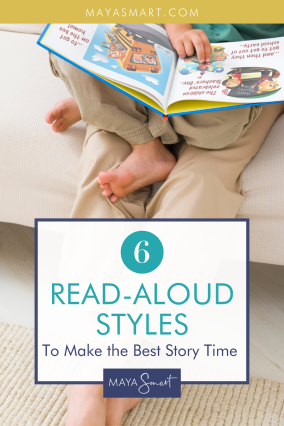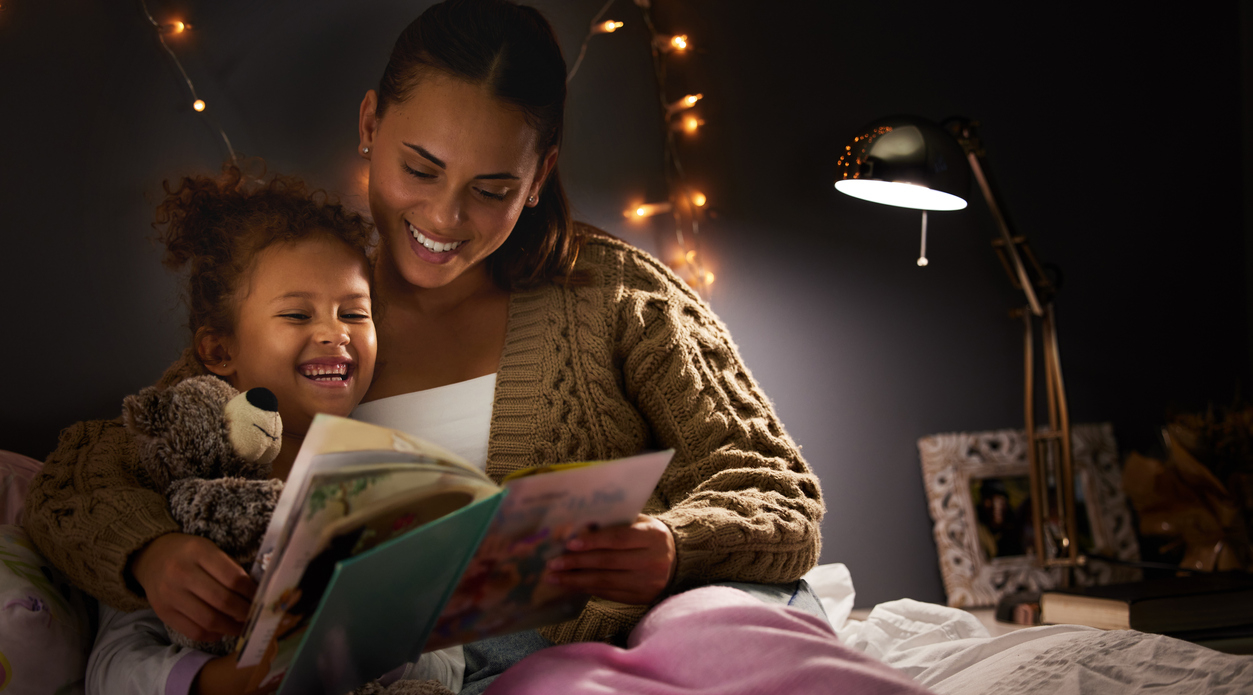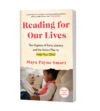By Maya Payne Smart
The term “read aloud” is deceptively simple—so self-evident in meaning that it seldom inspires discussion beyond admonitions to read with feeling and do it daily. But three decades of reading research reveals that there’s much more than reading aloud going on during the best story times. And, in fact, conversation that veers off the page may be as literacy-rich as the words in print.
Caregivers use more than 20 different kinds of speech during read-alouds, ranging from pointing out objects and urging kids to pay attention, all the way to explaining words’ meanings and connecting text to personal experience. It’s not literature, but dynamic parent-child conversation packs major benefits for future reading by encouraging kids to use their voices. To maximize the literacy-boosting benefits of reading aloud, parents should recognize the range of skills it can help kids develop and hone in on whichever ability their child is currently working on. (See Three Reasons to Read Aloud to Babies.)
Getting a sense of your own read-aloud style will help you consciously adapt it to best support your child’s evolving literacy needs. For example, do you tend to read straight through a text? Or do you pause frequently to reflect out loud on what you’ve read? Do you point at words or objects? Do you ask your child about what’s happening in the story or how it relates to them? Research says the more active, verbal engagement on your child’s part, the better—and asking them questions, plus responding to theirs as you go, encourages that.
A highly interactive approach didn’t come naturally to me. I knew reading to my daughter was important and did it regularly, but I thought of it more as a recitation than a dialogue, especially before she began talking. I took my cues on what a read-aloud was supposed to be from memories of Reading Rainbow, even sharing some of the exact same titles—Bringing the Rain to Kapiti Plain, Mufaro’s Beautiful Daughters, and Just Us Women. I brought a selection of diverse titles and my best Levar Burton voice to every reading.
My awareness that there were other, more interactive, responsive ways to read aloud (that a television show couldn’t fully convey) came from reading research studies and seeing video footage of real parent-child story time exchanges. Those examples gave me the perspective to see my style as one of many and the insight to know which elements of other approaches might benefit my daughter as she aged. It was a gift to discover that what I’d labeled distracted and off-task talk was actually the kind of smart engagement that fuels language skills and expressive ability. That it took longer to get through a story was no longer a problem once I viewed these interruptions and digressions as encouraging my child to talk, and not merely listen.
Here I’ve defined six not-particularly-scientific (but still research-backed) parent read-aloud types and offered some tips and pointers to keep in mind. See if you can spot a bit of yourself in some of the types below. I know I’ve worn several of these hats during my tenure as a parent—sometimes all in one sitting.
The Performer
This parent brings the drama. She has a voice for every character and facial expressions, too. Her intent is to captivate and immerse her listeners in the world of story. She feels successful when her child sits rapt on the edge of the seat, waiting for the page to turn and the tale to advance. She lives for spontaneous tears and laughter, the surest signs that her little listeners were moved by the reading. Her danger zone is getting so wrapped up in the performance that she forgets to pause to ask children to verbalize their ideas and reactions, missing golden opportunities to build up their voices and expand on their responses, the stuff of early language learning.
The Therapist
This parent is deeply concerned with the social-emotional dimensions of every story. He reads characters’ facial expressions more than the text, ever alert to signs of happiness, fear, or distress. He doesn’t hesitate to relate the story to real-life experience and hunt for the moral of every illustration. He’s the parent most likely to utter the phrase, This book saved my life. His approach may be enhanced from time to time by calling kids’ attention to details regarding the print itself, book organization, and the way written and spoken language connect. (See my read-aloud tips for some examples of how to do this.)
The Drill Sergeant
This commanding parent tends toward the didactic, sees a lesson on every page, and questions her kids non-stop. Where’s the bunny? What is she doing with the ball? Where’s the word sunshine? What letter is that? No characters, words, or objects escape her notice or inquisition, which is great for directing attention and creating lots of opportunities for child response. She can soften and warm her approach by letting the story breathe and leaving space to notice (and follow) the child’s own interests.
The Griot
This parent has a book in hand but scarcely consults its pages, preferring to weave riddles, parables, and narratives all his own. He invites his children to tell their tales, too, giving full attention to their creations and responding with lavish encouragement and praise. The tellings and retellings are acts of creation and of culture, if unlikely teachers of print concepts. But there’s undoubted power in capturing kids’ attention, holding space for their imaginings, and making it all fun. This type of storyteller may love to bring wordless picture books into story time. He can draw kids’ attention to features such as the book title and illustrator’s name on the cover to teach a little print awareness before going his own way.
The Listener
This parent is the picture of responsiveness. She reads with fluency and expression, but stays attuned to her child. She pauses at even the hint of an utterance from her little one, affirms that she’s heard it, and answers by pushing the dialogue (and learning) further. Open-ended questions are her specialty, and story time delivers the richest vocabulary and language learning around. This mom loves the occasion that story time creates for closeness and the conversation it inspires. Luckily, all that talk is literacy-building too. This parent may draw largely on instinct in connecting to and nurturing her little one, but she can always benefit from some gentle focus on the details of print, too—check out my read-aloud tips for kindergarten readiness for ideas.
The Baton Passer
This parent is all about taking turns and doesn’t pass up any opportunities to get kids in on the action. Even before his little one can talk, this parent says your turn and listens attentively to whatever coo or babble comes next. As his toddler ages into a preschooler, he happily accepts the child’s narration of the pictures as “reading” and keeps on trucking. In early elementary, the parent and child alternate reading pages aloud, with the dad just jumping in to correct a misread, omitted, or mispronounced word on the child’s pages. This parent will love learning more about how literacy develops, delving into topics like reading expression. Now that’s raising a reader!
Did you see elements of your own reading style in any of the descriptions above? Do you see opportunities to try some new approaches?
Pin Me for Reference :



